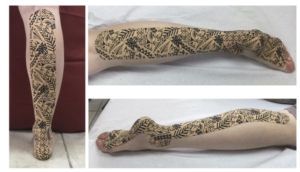Plantar flexion taping improves postural sway in those with Chronic Ankle Instability
Unlike other studies that have aimed to control inversion speed or load, Kodesh et al, in this study chose to tape in a way that created a plantar flexion force mimicking the posterior calf muscles. As the authors explain and reference, those with chronic ankle instability demonstrate “decreased plantar flexion and knee extension moments, decreased ankle and knee eccentric-concentric power and increased stiffness (Kim et al., 2018). Furthermore, individuals with CAI, exhibit altered muscle activity onset and decreased maximal torque (Fox et al., 2008; Herb et al., 2018) which may indicate difficulties in the production of sufficient joint moment, stiffness, ankle power and postural control (Kim et al., 2018; Sarvestan et al., 2020). These changes alter postural sway ability in individuals with CAI”
With this clear deficit in mind, the authors hypothesised that taping to generate a plantar flexion moment with Dynamic Tape Global would aid in load attenuation and postural control with antero-posterior sway being influenced more than medio-lateral.
Fig 1. The technique used in this study was applied in full plantar flexion such that the tape resists movement into dorsiflexion and then assists back into plantar flexion. This could be beneficial to the ankle strategy for balance maintenance when the deficits described above exist.
Subjects were allocated to the CAI group based on the outcome of the Cumberland Ankle Instability Tool(CAIT). This group was further divided into a Poor Stability group and a good stability group on the basis of their 30s single leg standing test. Those in the poor stability group were also found to have significantly higher circular area and COP AP sway at baseline than those in the good stability group.
The addition of Dynamic Tape Global resulted in significant improvements in velocity, circular area, path length and sway in the poor stability group. This improved in both those with CAI and those in the stable ankle (SA) group. There were no significant changes in the good stability group.
This study shows that where a clear deficit is identified and that is related to the condition or movements being observed, and when a Biomechanical Taping™ technique using Dynamic Tape Global® is applied in such a way to create a genuine force capable of addressing the deficit, significant improvement results.
Whether this improvement in postural control results in fewer ankle injuries in this group depends on whether that deficit is wholly or partially responsible for those injuries. A combination technique addressing the inversion movement may provide further benefits clinically. I for one, am not sure that I would choose to tape those whose mechanism of injury was plantar flexion/inversion into plantar-flexion (except during controlled rehab exercises) if they were participating in a jumping or running type of activity. I might consider it in those whose foot is planted fairly continuously during their activity e.g. skating.
While we are unable to determine whether the mechanism is purely due to a mechanical deceleration of motion assisting with sagittal plane control of the ankle, our own simple investigations like that in the video below have shown that these techniques can provide substantial resistance to dorsiflexion and assistance to plantar flexion.
Fig 2. Link to video showing the forces that can be introduced to aid in control of dorsiflexion
Furthermore, studies of kinesiology tape where the tape is applied in a lengthened position (minimal mechanical effect) have not resulted in the changes reported here. Further studies comparing a passive taping technique that uses the same tape and covers the same area of skin but applied in full dorsiflexion and with no tension, with an active technique like the one investigated here would help to dissect out the mechanisms further.
To learn how to apply this technique or undertake comprehensive training in Biomechanical Taping™ via our Accredited Biomechanical Taping Practitioner(ABTP) pathway visit our Education page.



